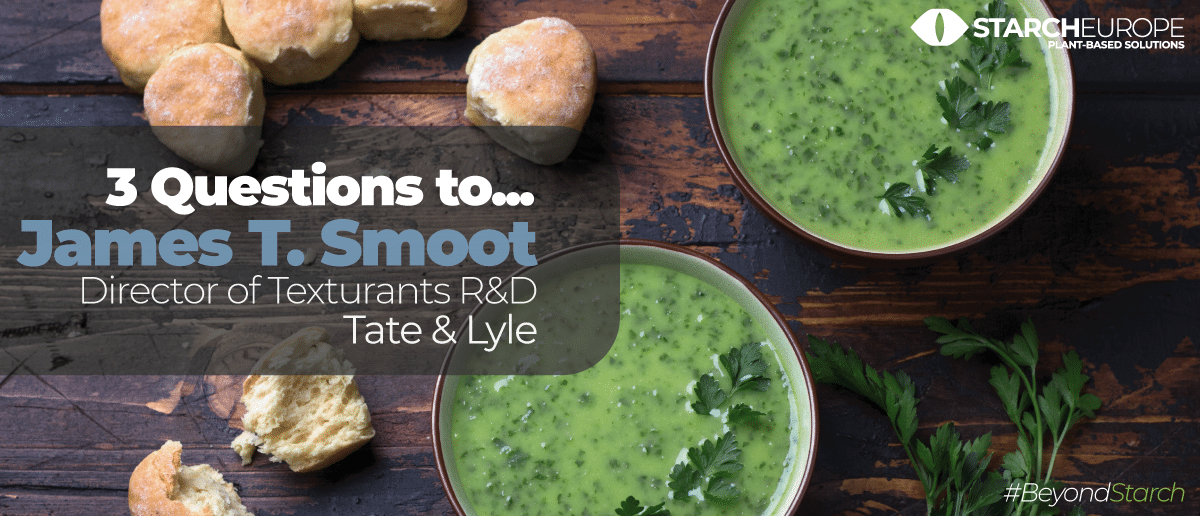Why do we love food and drink? When we consume a favourite product there are key sensory characteristics that we expect and enjoy – the taste, the texture, the mouthfeel, the appearance – and it’s by having these work in harmony, that brands deliver eating and drinking experiences that not only satisfy, they delight.
Starch Europe recently sat down with James T. Smoot, Ph. D., Tate & Lyle’s Director of Texturants R&D, to discuss the core role that texture plays in the creation of the new and innovative products that today’s consumers are looking for.
Take us through some of the complexities today in formulating or reformulating recipes?
James T. Smoot: As an industry, a lot of the focus has been on understanding ‘taste’, when actually taste and texture are intrinsically linked in successful products. Food and beverage producers adapt existing products or develop new ones for a host of reasons including to offer an enhanced eating experience, to improve a product’s nutrition credentials or make a nutrition claim, to make an ingredient label more consumer-friendly, or to manage cost without compromising stability, quality or shelf-life.
Every ingredient in a recipe has its own attributes. When you change one parameter during a reformulation, this will affect how all other ingredients interact in the ‘food matrix’, the complex interplay of nutrients in a food or beverage. It’s very rare that one ingredient is an exact match for another one. A texturant can enable a seamless reformulation by replacing other ingredients, so that the consumer can enjoy the same eating or drinking experience despite the changes.
How is the starch industry helping to perfect recipes?
Texture has always been a key consideration in product development or reformulation. Today, starch is the most common ingredient used in texture formulation design because with it, formulators are able to predict textural changes and adjust their formulation as needed. Texture is becoming even more important in product formulation because it is one of the main levers to create novelty and the impression of indulgence in the consumer experience.
Think of the recent launches offering contrasting textures, rougher or rustic textures, ‘mix ins’, healthy ‘add-ins’ such as added seeds. More significantly, emerging consumer trends, such as the growing popularity of plant-based diets, mean that producers have to replace ingredients with alternatives that deliver the same functionality.
Formulators often get stuck on the texture part. This is where our application scientists step in, and where tools like our Texture University™ provide support and solutions. That thousands of formulators have joined our educational webinar series since it launched in late 2018, shows just how much there is to learn to achieve the perfect texture.
Different texturants provide different functionalities, for example: thickeners, where starch particles in a liquid food such as a gravy will swell in water when cooked to increase the viscosity; and gelling agents, which may be used to create a strawberry jam, for instance, which has a low viscosity during preparation but becomes a gel once cooled. When we think about fat, for instance, we think about the great textural experience that it delivers. If a formulator takes fat out of a recipe, changing the melting behaviour of a product or its overall firmness or thickness, it can be challenging to know which texturising system can build these attributes back in.
How are you helping to meet consumer demands, and how important are the starch industry’s plant-based ingredients in this process?
Clean label is a major focus of our texturants research and product development because consumers are seeking simpler, healthier food and beverage products they can trust. They want to know what is in their food and drink so they can make an informed purchase decision. For instance, in Europe, we know that the vast majority - 77% - of shoppers read ingredient lists1. They are looking for familiar ingredients and want to understand where they originate from. Ultimately, they want transparency.
Clean label starches, such as those produced by Tate & Lyle, meet this demand; for instance, in Europe, ours label as ‘starch’, ‘maize starch’ or ‘tapioca starch’, depending on the raw material, helping shoppers feel assured that they’re consuming something familiar, that they understand. In the UK, the term ‘cornflour’, a well-known kitchen staple, can be used by producers on-pack ’
Alongside transparency, consumers are focused on health, sustainability and taste – opting for tasty products that are better for them and better for the planet. As a result, consumers are limiting the amount of meat they consume and are drawn to products that are plant-based yet nutrient dense. Our texturants are all plant-based and we are doing a lot of work with customers to develop foods and drinks without animal-based ingredients.
The challenge in creating a dairy-alternative, for instance, is how to build back in the texture that an animal protein would provide. The casein in traditional dairy products delivers a creamy texture in the mouth and a fast “meltaway”, which can be difficult to replicate. With starches, we can build that texture back in to deliver an indulgent experience that consumers love, helping us to care for our planet by offering foods and drinks with less climate impact, while in some cases lowering calories through the removal of fat. In parts of the world with limited access to refrigeration and where dairy is growing in popularity, such as in China, starches are helping to create shelf-stable, long-life dairy products, making nutritious products more accessible and supporting healthy living.
In summary, the range of food and drink available to meet different consumer needs and preferences has never been wider and continues to grow. The formulator’s texture toolkit is what makes many of these products possible, which is why we should celebrate starches!
___
Sources
- Tate & Lyle Proprietary Research, 2020, UK, France, Germany, percentages are “always” or “sometimes
- Mintel GNPD product launches (2016 – 2020) with at least one of the following claims: All natural, Ethical – Environmentally Friendly Product, Ethical – Sustainable (Habitat/Resource), Free from added/artificial additives/flavourings/preservatives, GMO free, Organic
- FMCG Gurus, January 2021

